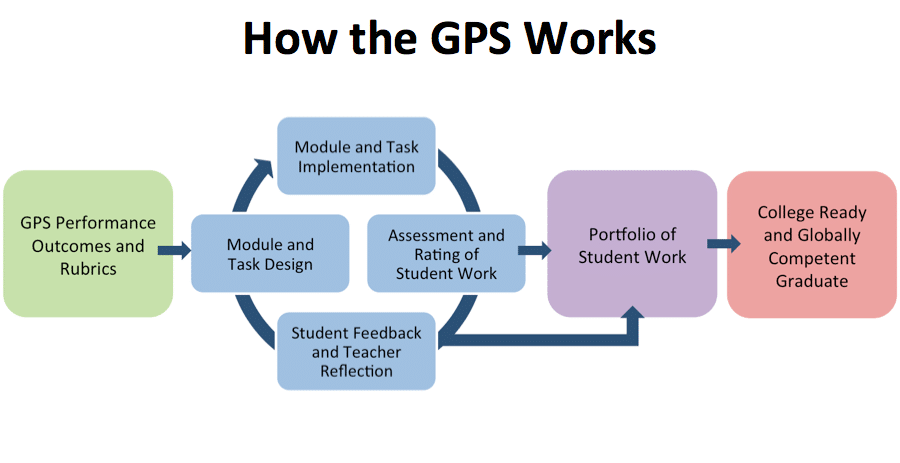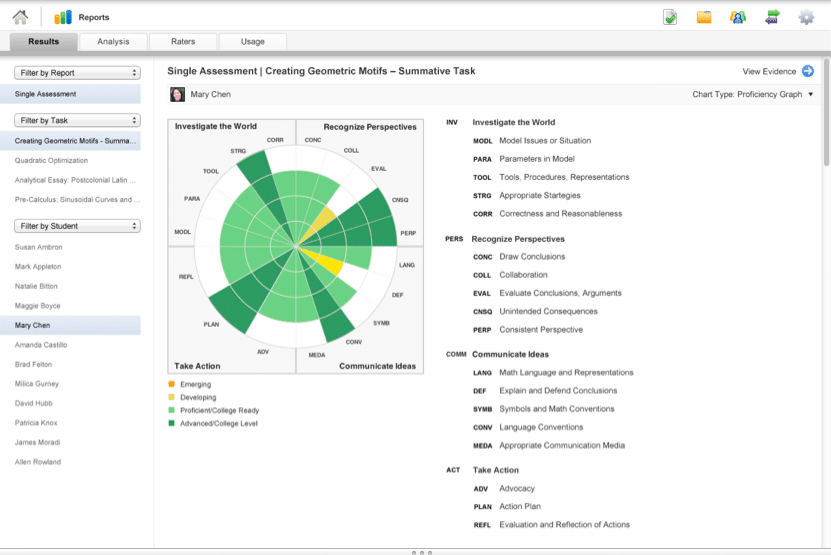A GPS for Competency Education
CompetencyWorks Blog

We are now starting to see whole networks of schools move towards competency education. The Asia Society, which has 34 schools in their International Studies Schools Network (ISSN), has four schools (Newfound Regional High School in Bristol, NH; Sharpstown International School in Houston, TX; and two schools in Denver, CO – the Denver Center for International Studies and the Denver Center for International Studies at Montbello) working together to build a Graduation Performance System (GPS) as the basis for a mastery-based system that awards credit based on proficiency in core courses. They are designing the GPS with an eye towards integrating anywhere/anytime learning opportunities that include community- and digitally-based learning environments.
The ISSN has a focus on preparing students for global competence, with an activist dimension, that includes but goes beyond the Common Core and our national focus on college and career readiness
Background
The ISSN schools have organized curriculum and learning pathways into 6 core subject disciplines and 4 domains of global competence (investigate the world, recognize perspectives, communicate ideas, and take action). They continue to use grade-level benchmarks as a way of organizing learning progressions and assuring proficiency along the way.
Competencies are designed with “I Can” statements. For example: I can develop a mathematical model that fits a particular situation. This means that I can use mathematics to create a representation, description, or quantification of some aspect of a situation. It also means that the model should use all the relevant data and information provided.
Curriculum is modularized with each module having learning activities and tasks that students use to demonstrate their learning. Most wonderfully, the rubrics that define the learning progression through the grade levels are aligned so that what might be considered proficient in 10th grade is emerging in 12th grade. What this means is if a student enters or transfers in 2 grade levels behind, teachers and the students themselves can find themselves on the rubric, knowing what they are going to need to learn and do to get on-track. With many students across the country two or more years behind, this is a breakthrough in terms of explicitly designing pathways to meet the needs of those students.
ISSN Schools are very intentional in their curriculum design. The quality components of the curriculum include clear expectations, authentic learning experiences, student-centered learning, and multiple opportunities to reach mastery. For ISSN schools, student-centered means providing “a collaborative environment in which teachers and students understand the expectations and share responsibility and ownership for all learners reaching proficiency.”
Graduation Performance System
The GPS is designed to provide a performance-based and technology-driven system of curriculum, instruction, and assessment. Through GPS professional development, teachers can:
• Create and implement rigorous globally-focused curriculum and instruction
• Assess student learning based on demonstrated proficiency
• Guide all students toward high achievement, on-time graduation, and global competence
It’s pretty difficult to explain everything the GPS system can do, but here are a few highlights. The four ISSN schools are using Show Evidence, a new product designed to manage assessment data for students especially for work that demonstrates deeper learning (i.e. the higher levels of Blooms taxonomy and Webb’s knowledge frameworks).
Evidence of Learning: Students can upload their learning tasks so that teachers can assess their learning (not test, assess), providing feedback quickly and easily. Given the stronger emphasis on writing in the Common Core, Show Evidence makes it pretty easy for teachers to provide feedback that is explicitly tied to standards.
Transparent Tracking of Progress: There are a lot of views to direct everyone in determining where they need to focus. Students can see their progress. Teachers can look across a class with color-and shape-based coding to help them make quick decisions. The colors progress from orange to green to provide a visual indication of a student’s level of proficiency from 1 –Emerging up to 4 – Advanced. The circled numbers are a score that represents work across multiple performance outcomes within a single domain of global competence (Investigate the World, etc.). Two views are shown below. The first shows how one student is doing in reaching proficiencies in a course. The second is across an entire class, helping the teacher to figure out where they might need to group students, provide more instruction or a different type, or pay attention to individual students that are starting to lag behind.
One of things that the schools involved in shaping the GPS are learning is that they need to develop collaborative professional learning group, or as one school calls them, “authentic assessment teams,” for performance-based assessment design and delivery. These teams mutually provide feedback and reflection regarding instructional planning and practice. This is especially important in relation to expanded learning opportunities in the community. There are so many variables in community-based projects, it is very important to ensure an inquiry-based approach to develop the desired competencies.
Badging: Competency, Validation, and Reliability
Asia Society is developing a Globally Competent Youth Badge System that will give high school students the opportunity to earn up to five badges based on the four domains of global competence. Students will earn each of the first four badges by demonstrating proficiency in each of the four domains of global competence, and then the culminating fifth badge will be based on a student’s proficient defense of their body of work/evidence across all four domains. Asia Society is working with two partners, Harvard’s Project Zero and the TeachUNICEF, to validate the badges and their connection to global competence.
One of the big issues in designing badges is reliability. It may be one of those concepts that drive our work, but the cost of it may make it difficult to fully attain. To earn the badges, students will complete several GPS tasks (called “challenges” in the badging system) and upload their work to ShowEvidence, and then trained teachers will score their work on the GPS rubric. Therefore, each badge will be linked to a collection of evidence (proficient student work and written reflections) in ShowEvidence that will show how the student earned the badge. Over time, Asia Society expects that the badges will become part of students’ GPS portfolio on ShowEvidence, certifying that they are globally competent and college ready by graduation.
—-
A final thought — With their 34 affiliates operating in seven states across the US, Asia Society may end up playing a critical role in distributing knowledge about competency education as their schools convert to competency-driven designs.


